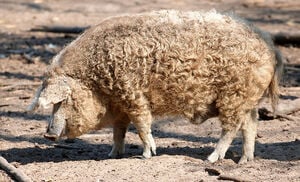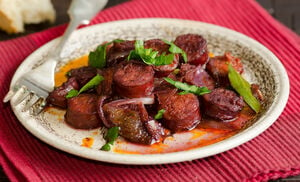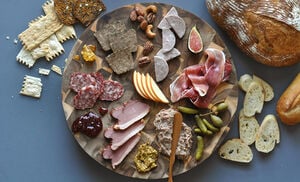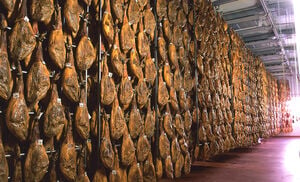Mangalica Ham
-
In Stock
Air-cured jamón is a Spanish culinary icon and a true pleasure for the taste buds. This particular ham is made with pork from the Mangalica, a heritage hog native to Hungary, that’s distinctive for its thick coat of curly hair and abundant intramuscular fat. Popularly known as the “Kobe beef of pork,” the dark meat and abundant marbling inherent to Mangalica make it the perfect candidate for extended curing. Fourth-generation maestro jamoneros - literally “masters of ham” – cure the Mangalica ham for at least 3 years at high altitudes in the fresh, clean air of the Rasillo de Cameros Mountains. The ham they create is intensely flavorful and streaked with creamy fat that melts on the tongue. With this whole ham and stand you can become an expert cortador – a ham carver. Enjoy Mangalica ham sliced paper-thin, and served with wine, cheese, nuts, and fruits – or make it the star of a charcuterie board.
Also Available:
Iberico Ham
- Ham made from heritage-breed Mangalica pork
- Fully air-cured for 36-42 months in Spain
- A pure expression of jamón
- Raised on pasture in the Hungarian Steppe
- Controlled, all vegetarian diet
- Spanish charcuterie
- No nitrites added
- High in Omega-3 fatty acids and natural antioxidants
- Ships ready to carve and serve
- Buy with D'Artagnan wooden stand for easy carving and storing
- Shelf life of six months if kept refrigerated
- Product of Spain
- Subscription Eligible
Please be sure to read our tips before serving. There are carving techniques that you need to know before you start.
Watch our video to see the correct carving technique. This cured ham needs to be handled properly for the best experience.
Be sure to trim the thick layer of yellow fat off before carving, but only in the area you are going to carve. This is a natural build-up that occurs in the long curing process as a barrier to the air, but it is bitter tasting, and not suitable for eating. The layer is protective, so keep the slabs you trim off to place back on top of the carved area when you store it.
Use a long, flexible knife for slicing.
Cured ham is best served at room temperature.
A bone-in ham will continue to cure, even after you carve it.
Store it in a cool, dry place, loosely covered with a cloth and allow it to breathe. In Spain cured ham is often left in the stand on a sideboard (covered with a cloth), so people can just slice off a piece or two for a snack as they pass by. This daily attention seems ideal for a cured ham. If you will not be slicing it for a few days, it is best to store in the refrigerator and bring up to room temperature before slicing. If the surface looks dry, put olive oil on a cloth and place over the dry area.
Mangalica pork, Mediterranean sea salt
Our Spanish hams are made by fourth-generation maestro jamoneros - literally "masters of ham" - who marry the best of tradition with the latest in technology. They begin with rare-breed pork from black Iberian and Mangalica hogs, which are raised humanely in pastures and oak groves. The hams are made with all-natural ingredients and are cured at high altitudes in the fresh, clean air of the Rasillo de Cameros Mountains of Spain. With nothing but salt and time – anywhere from 18 months to 42 months – they bring the culinary alchemy of curing to an art form.







